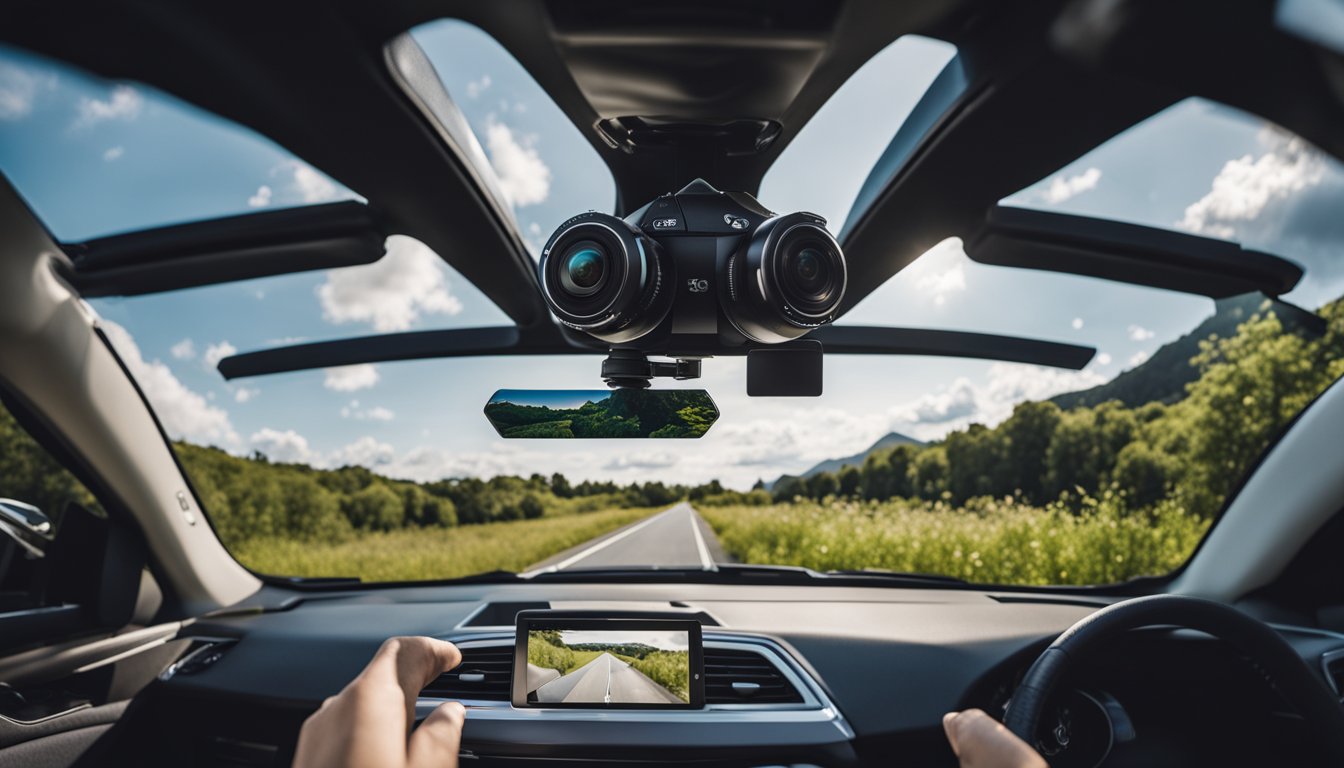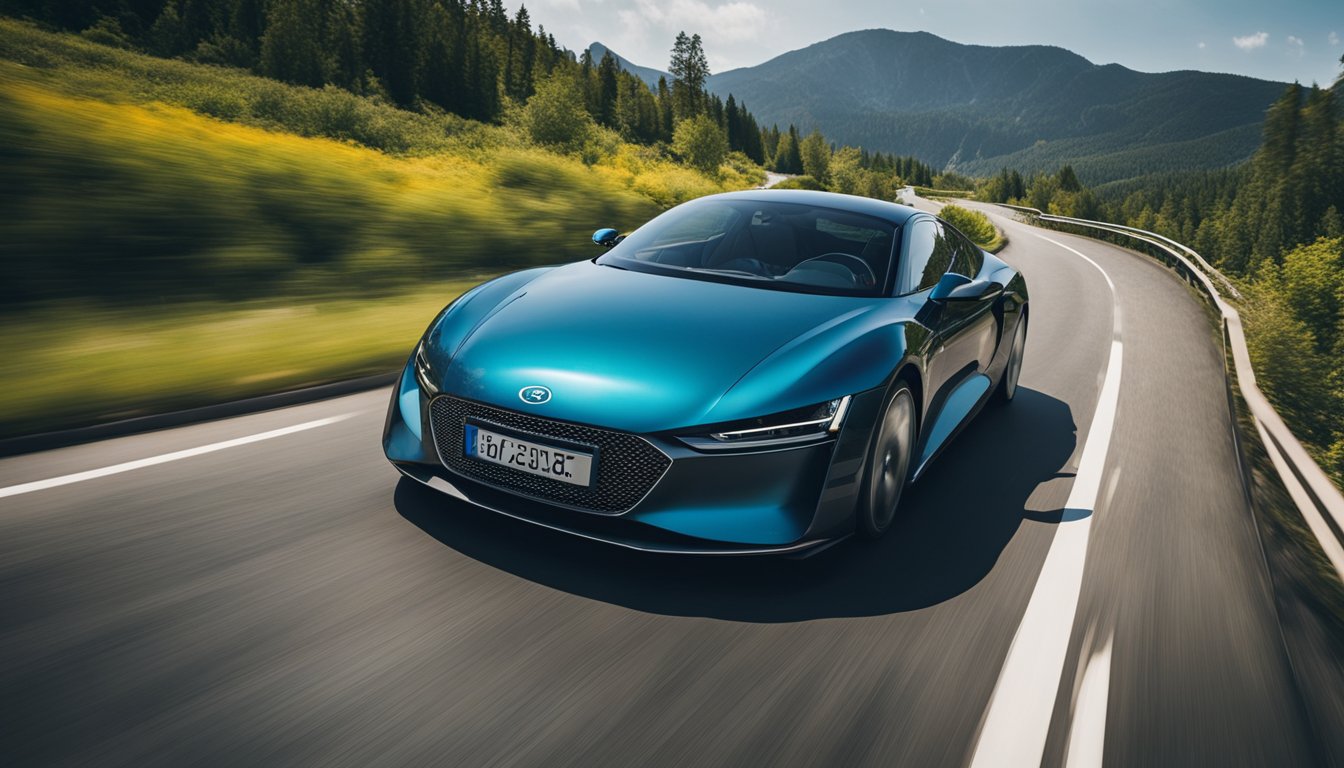Adding a 360-degree camera to your car can elevate your driving experience by enhancing visibility and safety. A 360-degree camera, also known as a surround view system, utilizes multiple cameras around the vehicle to create a bird’s-eye view image. This allows you to see all angles around your car on a single screen, making parking and maneuvering in tight spaces much easier.

While newer models may already be equipped with this technology, the good news is that you can also retrofit a 360-degree camera system into older vehicles. Aftermarket kits provide a variety of options for those looking to make this upgrade, allowing for a range of camera qualities and integration levels. Whether you aim to improve safety or simply want the convenience that modern technology offers, adding a 360-degree camera system to your car is a smart move.
Key Takeaways
- Enhance safety and visibility by installing a 360-degree camera system in your car.
- Retrofitting this technology is possible for older vehicles with aftermarket kits.
- A variety of options and integration levels exist, catering to different preferences and budgets.
Understanding 360-Degree Camera Systems
https://www.youtube.com/watch?v=xqWkJJOcU4g&embed=true
When exploring the world of vehicle safety and convenience features, you might come across 360-degree camera systems, also known as surround view or top-down view camera systems. These ingenious systems stitch together the feed of multiple wide-angle cameras, usually mounted at the front, rear, and sides of your car, to present a holistic view of your surroundings.
Benefits:
- Increased Visibility: On your dashboard screen, you’ll see a real-time, bird’s-eye view of your vehicle and its environment, making it simpler to spot any obstacles.
- Ease of Parking: Maneuvering into tight spots becomes less challenging as the top-down view provides a comprehensive look at the parking space and your car’s position relative to it.
How It Works:
- Wide-angle cameras are strategically placed to cover the vehicle’s blind spots.
- The images from these cameras are combined in real-time to create a single, cohesive view.
- This unified image is displayed on your car’s monitor, giving you a virtual 360-degree perspective.
Types of Views:
- Bird’s-eye View: A simulated aerial view of your vehicle.
- Front and Rear Views: Helps in avoiding pedestrians or obstacles that are directly in front of or behind the vehicle.
- Side Views: Alerts you to anything that might be approaching from the sides.
If you’re wondering how to add such functionality to your car, there are aftermarket solutions available which can potentially be integrated depending on your vehicle’s specifications. These kits include all the necessary components, allowing you to enhance your driving experience with a surround view camera system.
Benefits of Adding a 360 Camera to Your Car

When you consider upgrading your car with new technology, a 360-degree camera is a feature that offers both safety and convenience. Think of it as having an extra set of eyes where you need them most.
Elimination of Blind Spots: Traditional rearview mirrors can’t show every angle around your vehicle. A 360-degree camera fills these gaps, giving you a complete view of the area surrounding your car, helping to avoid potential accidents.
Ease of Parking: Navigating into a tight parking spot becomes much simpler with a bird’s eye view. You can observe your car’s position relative to other vehicles and obstacles, making adjustments on the fly without the usual uncertainties.
Enhanced Security: Cameras continuously monitor your car’s surroundings, adding an extra layer of security. This is especially useful in busy areas where pedestrians and moving vehicles pose a constant threat.
Here’s a quick rundown of improvements you can expect:
| Aspect | Improvement |
|---|---|
| Visibility | Enhanced |
| Parking | Simplified |
| Security | Increased |
| Maneuvering | Safer |
« 360 Cameras for Semi Trucks: Enhancing Driver Visibility and Safety
Best 360 Cameras Under $100: Affordable Options for Immersive Photography »
By integrating a 360-degree camera system, you’re not just improving your driving experience; you’re investing in a safer journey every time you hit the road.
Comparing OEM and Aftermarket Camera Options
https://www.youtube.com/watch?v=BGG-ux-sZJo&embed=true
When considering adding a 360-degree camera system to your car, you have two main paths to explore: opting for an Original Equipment Manufacturer (OEM) system or choosing an aftermarket kit. Here’s how they compare:
| Feature | OEM Systems | Aftermarket Kits |
|---|---|---|
| Integration | Seamless with vehicle dash and controls. | May require additional setup and integration. |
| Compatibility | Designed for specific models. | Broadly compatible with many models. |
| Installation | Typically done by authorized dealers. | Can be DIY or require a professional. |
| Cost | Generally higher due to branding and quality. | More varied, often less expensive. |
OEM systems are often specifically made for your vehicle by automakers. This means they fit perfectly and maintain the vehicle’s aesthetic. They’re typically more reliable in terms of compatibility and function as if they were installed right off the factory floor. However, such systems might be more expensive due to the brand premium.
In contrast, aftermarket 360 car camera systems offer more versatility and are often less costly. You can find kits that suit a range of vehicles, regardless of make or model. Installation can be more hands-on, allowing for customization. Some well-known aftermarket options, such as the CarThree 360 Camera System or the Weivision 360 Camera System, can offer good functionality at a fraction of the cost of OEM systems. However, quality can vary, and it’s essential to ensure compatibility with your vehicle to avoid issues with the display or controls.
Remember to consider warranty implications when adding non-OEM features to your vehicle. Upgrading your vehicle with a 360-degree camera system can provide a better driving experience, whether you choose an OEM system for its perfect fit or an aftermarket kit for its cost-effectiveness and versatility.
Installation Basics of 360 Cameras in Cars
https://www.youtube.com/watch?v=gkdTFsMK8FA&embed=true
Installing a 360 camera in your car can significantly enhance your driving experience by providing a complete view around your vehicle. Here is a simplified guide to help you begin the installation process.
Choose the Right System: Your 360 camera system will usually include multiple cameras. Ensure that it’s compatible with your car model.
Identify Mounting Locations: Commonly, cameras are mounted under side mirrors, near the front grille, and above the rear license plate. The goal is to cover all angles around the car.
Mounting the Cameras:
- Side Mirrors: Place the cameras beneath the side mirrors to capture the sides of your vehicle.
- Front Grille: Install a camera here to monitor the area in front of your car.
- Rear Placement: Typically above the license plate, this camera watches the rear.
Camera Calibration: After mounting, the cameras require calibration to stitch the images together, creating a seamless 360-degree view.
Connection to Power: Cameras need to be connected to a power source, like your car’s electrical system, and this often requires professional assistance.
Display Installation: Lastly, install the display screen in a convenient location on your dashboard to easily view the camera feeds.
Remember to carefully follow the manufacturer’s instructions or seek professional installation to ensure the system functions correctly. Proper placement and calibration are crucial for optimal visibility and safety.
Integration With Vehicle Systems
https://www.youtube.com/watch?v=dKQTy7a4hbw&embed=true
When adding a 360 camera to your car, integrating it with your vehicle’s existing systems is essential. This ensures that the camera’s functionality is seamless and enhances your driving experience.
Infotainment System Compatibility:
Your car’s infotainment system is central to integrating a 360 camera. It should support the camera input so you can conveniently display the camera feed.
- Infotainment Screen: The camera’s output will be visible on your infotainment screen. Modern systems will have a touchscreen interface, making it easier to switch between different camera views.
Software Alignment:
Aligning the camera’s software with your vehicle’s system is critical for a harmonious setup. It often requires:
- Regular updates for bug fixes and new features.
- Calibration of views, especially the top view, to match your car’s dimensions.
Mounting and Display:
- The camera should typically be mounted discreetly around your dash area.
- The system should ensure a clutter-free display, providing clear and crisp images.
By considering the integration with your vehicle systems, you’ll enhance not just the safety but the comfort and capability of your car’s technology suite.
Model-Specific Camera Insights
https://www.youtube.com/watch?v=nbv_uDoNTWs&embed=true
When you’re considering adding a 360 camera to your vehicle, keep in mind that compatibility can vary significantly between different manufacturers and models. Here’s a quick breakout to guide you through:
Hyundai & Kia: Newer models may have pre-installed options, but aftermarket install is possible with proper integration kits.
Toyota & Nissan: These brands offer select models with built-in 360 cameras. For older models, you can opt for aftermarket systems.
Volvo & Audi: Known for their advanced technology, these brands often include 360 cameras in premium packages.
BMW & Mercedes-Benz: Most luxury-line models come with a 360 camera system, and retrofitting is a streamlined process for these high-end vehicles.
Land Rover: With a focus on visibility for off-roading, adding a 360 camera can enhance your experience.
Mazda: They provide built-in options for some models; meanwhile, aftermarket solutions can fit seamlessly with a bit of research.
Chevrolet Trucks & SUVs: Have select models with factory 360 cameras, especially in higher trims. However, there are robust aftermarket kits available designed for trucks and SUVs.
Before purchasing an aftermarket 360 camera system, it’s worth consulting with a professional installer who has experience with your specific vehicle to ensure the best fit, integration, and functionality. And remember to always prioritize driving safety and compliance with local regulations when installing new equipment in your car.
Upgrading an Older Car With a 360 Camera
https://www.youtube.com/watch?v=0uqX6cSEFu4&embed=true
Upgrading your older car with a 360-degree camera can be a transformative experience. Modern technology isn’t exclusive to new vehicles; with aftermarket kits, you can enjoy enhanced visibility and safety in your trusted ride.
When considering an addition like this, keep in mind that aftermarket kits vary in complexity. For a smooth installation process, verify that the kit is compatible with your car’s make and model. Also look for kits that come with all necessary components, such as cameras, wiring, and a display monitor.
360 cameras are more advanced than traditional backup cameras, as they provide a comprehensive view around your vehicle. This panoramic perspective can assist with parking, navigating tight spaces, and spotting unseen hazards. Here’s a simple breakdown:
Benefits:
- Increased safety: Minimize blind spots.
- Easier parking: Visualize your car in tight spots.
- Peace of mind: Always know what’s around you.
Installation:
- Choose the right camera kit for your car.
- Follow the installation guide meticulously or consider professional installation.
- Connect the cameras to a central display.
Remember, while some kits are designed for DIY enthusiasts, others may require professional installation. Researching your car’s layout and the chosen camera system’s specifications can help you decide whether to tackle the installation yourself or hire an expert.
Incorporating a 360-degree camera system into your older car can be a fantastic upgrade, bring it closer to modern standards, and significantly enhance your driving experience.
Choosing the Right 360 Camera for Your Vehicle
https://www.youtube.com/watch?v=5l7LH1BSCb8&embed=true
When selecting an aftermarket 360-degree camera for your car, it’s essential to consider a few key features. Firstly, camera quality is vital; you want a camera that provides a high-resolution image to ensure clear visibility in various lighting conditions.
- Look for cameras with night vision capabilities for enhanced low-light performance.
- Check the field of view; a wider angle offers better coverage around your car.
- Consider ease of installation and compatibility with your vehicle model.
Regarding positioning, you’ll want a top-down view to gain comprehensive coverage. Cameras that stitch together images for a seamless picture are ideal for this purpose. The mounting should be non-obstructive and ideally central to maintain the aesthetics of your car’s interior.
Compatibility with your vehicle’s infotainment system should also be considered:
- Ensure the camera system can integrate smoothly with your car’s existing display.
- Some systems come with their own monitor if your car lacks a display.
Lastly, durability is a non-negotiable factor. The camera should be able to withstand all weather conditions. Look for water-resistant or weatherproof models to ensure longevity.
Remember to check online reviews and verify the product’s quality before making a purchase. A well-reviewed 360-degree camera can significantly enhance your driving experience by providing added security and convenience.
Professional vs DIY Installation
https://www.youtube.com/watch?v=ITNq3BilX8g&embed=true
When you’re looking to enhance your car with an aftermarket 360-degree camera, you have two main routes to consider: a professional installation or doing it yourself (DIY).
Professional Installation:
- Quality Assurance: With professionals, you’re paying for expertise and peace of mind that your camera system and any associated parking sensors will function correctly.
- Time-saving: A professional can complete the job quickly, allowing you to enjoy the benefits without the hassle.
- Warranty: Services often come with a warranty, offering protection for your investment.
| Pros | Cons |
|---|---|
| Expert installation | Higher cost |
| Time efficiency | Scheduling required |
| Warranty protection |
DIY Installation:
- Cost-Effective: You can save money by avoiding labor costs.
- Learning Experience: It can be rewarding to install the camera yourself, gaining new skills in the process.
- Flexibility: Work on the project on your own timetable without the need to schedule an appointment.
| Pros | Cons |
|---|---|
| Lower overall cost | Risk of improper installation |
| Personal accomplishment | Time-consuming |
| Schedule at your convenience | No professional warranty |
Key Tips for DIY:
- Follow instructions carefully from aftermarket kits to avoid common pitfalls.
- Ensure you have all the necessary tools before starting.
- Take your time to understand each step of the process.
Remember, your comfort level with automotive DIY tasks should guide your decision. If you’re not confident in your ability to handle the complexity of installing multiple components and wiring, professional installation might be the way to go.
Troubleshooting Common Issues
https://www.youtube.com/watch?v=3QmJq3lRI7c&embed=true
When you’re having trouble with your 360-degree camera system, it can be frustrating. Here’s how you can address some common issues with a friendly, problem-solving attitude:
Camera Visibility: If your cameras are giving a blurry image, check for any dirt or obstructions. Clean the lenses gently with a soft, clean cloth.
Calibration Problems: Should your camera view look skewed, it might need recalibration. Consult your vehicle’s manual on how to reset the camera alignment using the system settings within your infotainment system.
Software Glitches: Sometimes, the camera system might freeze or not display correctly. A simple restart of the system can often resolve this. Turn off your car, wait a few minutes, and start it up again.
Wiring Issues: If the camera isn’t powering on, this could be due to a wiring problem. It’s best to contact a professional for this, but you can check if all visible wires are intact and properly connected.
Software Updates: Out-of-date software may cause compatibility issues. Ensure your system’s software is up-to-date by following the update procedure outlined in your car’s manual or the camera’s instruction guide.
Camera Failure: Should a camera not work entirely, you might need a replacement. Before purchasing a new one, verify it’s not a software or connection problem.
If these steps don’t resolve your issue, it may be necessary to consult with a specialist. Remember, handling car electronics can be complex, and there’s no shame in seeking expert assistance for your 360-degree camera system.
Frequently Asked Questions
https://www.youtube.com/watch?v=k4N8x_H06MY&embed=true
In this section, you’ll find straightforward answers to common queries regarding adding a 360-degree camera to your vehicle and making the most out of its capabilities.
How to install an aftermarket 360 camera on a car?
To install an aftermarket 360 camera on your car, you’ll typically need to mount cameras on the front, rear, and sides of your vehicle and connect them to a central processing unit that stitches the feeds together into a cohesive view.
What are the most affordable cars that come with a 360-degree camera?
Several affordable car models offer 360-degree cameras, with the Nissan Kicks and Hyundai Santa Fe often being highlighted for providing these advanced systems at a more accessible price point.
Which Toyota models come with a 360 camera feature?
Toyota models such as the Highlander and the RAV4 are known to provide a 360-degree camera feature, enhancing their safety and convenience for drivers.
Are there used car options that have a 360-degree camera system?
Yes, you can find used vehicles equipped with a 360-degree camera system. Models from brands like Nissan, Infiniti, and BMW frequently appear on the used car market with these advanced camera systems.
What benefits does having a 360 camera in your car provide?
Having a 360 camera in your car provides several benefits, including improved visibility around your vehicle, assistance with parking, and a reduced risk of collisions or scratches, especially in tight spaces.
Can a 360-degree dash cam be installed for car racing purposes?
Yes, a 360-degree dash cam can be installed for car racing, offering a comprehensive view of the surroundings that can be critical for performance driving and post-race analysis.












